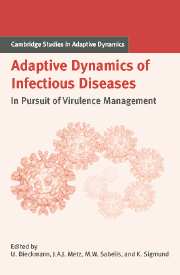Book contents
- Frontmatter
- Contents
- Contributing Authors
- List of Boxes
- Notational Standards
- 1 Introduction
- A Setting the Stage
- B Host Population Structure
- C Within-Host Interactions
- Introduction to Part C
- 9 Super- and Coinfection: The Two Extremes
- 10 Super- and Coinfection: Filling the Range
- 11 Multiple Infection and Its Consequences for Virulence Management
- 12 Kin-selection Models as Evolutionary Explanations of Malaria
- D Pathogen–Host Coevolution
- E Multilevel Selection
- F Vaccines and Drugs
- G Perspectives for Virulence Management
- References
- Index
- International Institute for Applied Systems Analysis
Introduction to Part C
Published online by Cambridge University Press: 15 January 2010
- Frontmatter
- Contents
- Contributing Authors
- List of Boxes
- Notational Standards
- 1 Introduction
- A Setting the Stage
- B Host Population Structure
- C Within-Host Interactions
- Introduction to Part C
- 9 Super- and Coinfection: The Two Extremes
- 10 Super- and Coinfection: Filling the Range
- 11 Multiple Infection and Its Consequences for Virulence Management
- 12 Kin-selection Models as Evolutionary Explanations of Malaria
- D Pathogen–Host Coevolution
- E Multilevel Selection
- F Vaccines and Drugs
- G Perspectives for Virulence Management
- References
- Index
- International Institute for Applied Systems Analysis
Summary
For a long time, epidemiology essentially dealt with the spread of diseases within a population of susceptible, infected, or recovered hosts. Progress in microbiology and molecular biology has allowed us to study the full life cycle of pathogens: this comprises not only their transmission from one host to the next, but also their population dynamics within individual hosts. It has become clear that withinhost interactions between pathogen strains can profoundly influence selection on virulence.
This part therefore concentrates on the ecology and evolution of microparasites within the biosphere presented by a single host. In particular, it focuses on two aspects of utmost importance for understanding the combined effects of mutation and within-host selection. The first aspect is of an ecological nature and relates to competition between different strains for the ecological niche offered by the host. In particular, competitive exclusion among strains can lead to the takeover of the host by the most virulent parasitic strain: this is the case of superinfection. Coexistence of several strains, on the other hand, leads to coinfection. The second aspect of within-host interaction that is crucial for virulence evolution is kin selection; it is based on genetic considerations, in particular on the genetic relatedness of parasites to each other. Very roughly speaking, the two effects pull in opposite directions: competitive exclusion tends to increase the virulence level, whereas kin selection tends to decrease it.
In Chapter 9, Nowak and Sigmund investigate simplified models of multiple infection.
- Type
- Chapter
- Information
- Adaptive Dynamics of Infectious DiseasesIn Pursuit of Virulence Management, pp. 122 - 123Publisher: Cambridge University PressPrint publication year: 2002



